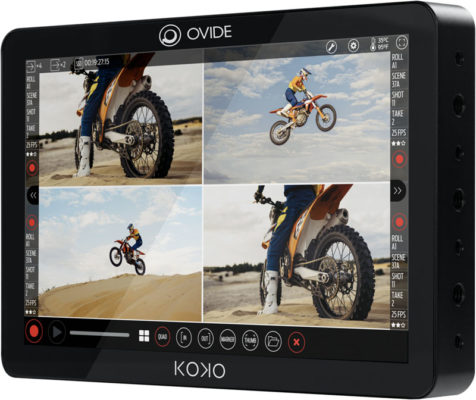
It’s not very often that discontinued products spring back to life. In fact, if anyone can think of any examples of something being so spectacularly popular that it was resurrected after having been entirely EOL’d, it’d be interesting to hear about it in the comments. This sort of technological necromancy is rare enough that the Ovide Koko recorder, based on a recapitulation of Convergent Design’s much-loved Odyssey series, has garnered
a lot of attention for that reason alone.
Sergi Ovide Maudet is managing director at (the eponymous) Ovide, in Badalona, Spain. He describes the Koko recorder as the product of a market perhaps still in some flux after the explosive growth, and then abrupt normalisation, of monitor-recorders in general. Making Convergent’s design back into a product, though, involved some awkward practicalities. Some of those revolved around the hardware components, including the Odyssey’s admired OLED display. “Convergent Designs stopped manufacturing their devices,” Maudet confirms. “The components became obsolete, and there was a big fight in prices, so it wasn’t worthwhile to develop a new design. Sound Devices was the same, so there was only Atomos and Blackmagic doing similar stuff.”
Resurrection
The instinct to bring Odyssey back to life began, Maudet goes on, with an internal requirement. “We need something like the Odyssey – we’re also kind of a rental company, and we had the same need anyway. We felt what was in the market wasn’t what we wanted – and not even Odyssey, nor [the Sound Devices] Pix-E were designed for DITs. That’s what people were using them for, but they were missing functionality. So, we thought we’d do something similar. We wanted to do it, we had the engineers to do it, but we realised that building it from scratch would be a long job. Still, one of the most complex things was the ProRes encoding, so and we reached out to Convergent to see if we could purchase some of their IP and get faster to market.”
Convenient as it sounds to pick up where Convergent had left off, the firmware behind Odyssey had been part of a working product under constant revision, not a neatly-packaged module of code designed for commercial sale. Part of the negotiation process therefore involved enlisting Convergent’s assistance in using what Ovide had bought. “Convergent and us are very similarly-sized, family companies,” Maudet points out. “It was easy to understand each other. It took us some time, but it was easy to get to an agreement and that included support. It wasn’t easy to build around it, it wasn’t a Lego brick that you can build things around. It wasn’t like we bought it and never talked to them again.”
Integrating Convergent’s code with a new hardware platform kept Ovide’s engineers busy, but, as Maudet says, brought benefits, too. One of them was the bigger, brighter, sharper TFT-LCD display. “We built a new hardware platform based on a state-of-the-art, latest-generation FPGA which allows us to boot in one and a half seconds and be ready to record in two or three seconds – depending on the drive, as some of them are slow to mount. What we did was based on what Odyssey could do. We got the part that was usable, the codec and some of the test-and-measurement tools and expanded it to video assist. We have multiple ins and outs, simultaneous playback. We will be adding more and more measuring tools.”
A curated codec
Apple’s careful control of the ProRes codec is, in some ways, what has lend that codec its popularity as a dependable mezzanine in all sorts of situations. The change of platform, Maudet goes on, created a requirement to re-certify the code. “If you look at Apple Prores certified partners, we had to go through that again. You have to start from scratch. When we first presented [Koko], we said ‘you know which codec it is’, but we never said ProRes. All of the certification was good at IBC when we presented it, but the licensing wasn’t done and we couldn’t say ProRes.”
With the paperwork complete, Ovide was able to begin shipping early units in June 2023, with a clear intention to keep working on the firmware. The public reaction, meanwhile, was equal parts pleasant surprise and keen interest, particularly with regard to the excellent reputation the Odyssey series enjoyed for ongoing firmware updates which might create useful new features. “The idea with Koko is exactly the same,” Maudet says. “Of course there are things that can be done and things that are limited. We have to make decisions – one is that it’s a ten-inch display. People start asking for stuff, only you can’t see everything, there’s no space for certain things. And it can’t be a super-complex machine. It’s small, and if we put too many features, if we give you a massive amount of routing and tooling, you will have things that won’t go in the way you expect.” With Koko increasingly appearing in showrooms worldwide, if this isn’t enough to convince anyone of the company’s good intentions, Maudet concludes simply: “We’re going to create a tool that’s as powerful as possible.”
